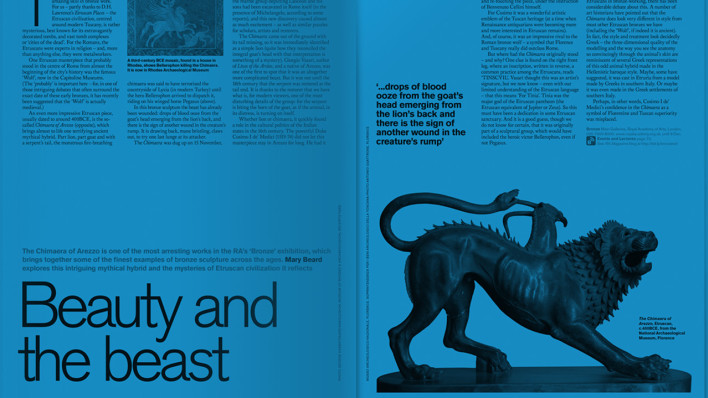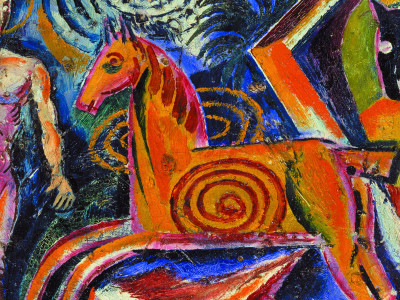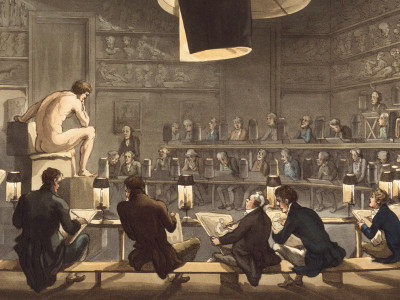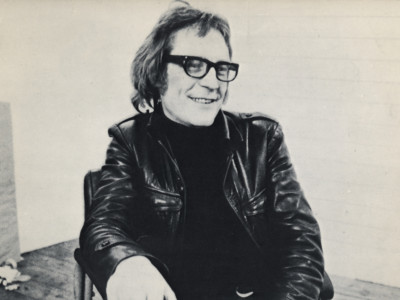
In the studio with Rose Wylie RA
By Fiona Maddocks
Published on 5 January 2016
In Rose Wylie RA’s Kent studio, paint spatters are everywhere. Fiona Maddocks meets the artist whose star is shining late in life.
From the Winter 2016 issue of RA Magazine, issued quarterly to Friends of the RA.
Rose Wylie’s front door looks as if it may not have been opened for years. A hand-painted sign above the lintel, just legible, instructs tradesmen to use the side entrance. Concluding that journalists might fall into that category, I turn to find the appropriate access when Wylie opens the door and welcomes me in. She is slight and striking, with chopped steel-grey hair. Her woolly clothes somehow manage to be stylish, and she trails a scent of vanilla.
Inside the 17th-century brick house, the space teems with purpose, each room running into the next, fluid and untrammelled. Books spill from shelves; papers, postcards, bottles, jars cover surfaces. Jasmine has found its way through the skylights in the dining-room, tumbling down in abundance. The long, rampant woodland garden is more dell than parterre, foliage almost enclosing the house.
"When the grass gets long I flatten it by treading on it," says Wylie, picking her way along a brick path which featured in a painting My Son, My Son, What have you Done, from 2011, a homage to the Werner Herzog film. Her eclectic inspirations include Almodóvar and Tarantino, as well as Egyptian art, Pompeii, fashion, jewels, regalia, uniforms. She has also painted, less typically since pastoral is not her usual mode, the field with sheep beyond the garden in a work called Willow Tree (2015). "I paint what I can see. This is what I see. It takes me a long time to do it, though people think it looks easy. This willow tree for example took weeks to get right."
Wylie has lived in this corner of rural Kent, surrounded by orchards, for nearly half a century. She and her husband, the artist Roy Oxlade, raised their three children here, having met as students at Goldsmiths. He died in 2014. Wylie, 81, now lives alone. She works prodigiously: "It’s always difficult, but the compelling demands of painting keep you at it." Today her star is in the ascendant. She won the 2014 John Moores Painting Prize, and was awarded the Charles Wollaston Prize for "most distinguished work" in this year’s Summer Exhibition, following her election as an RA earlier this year. Recently she showed at Frieze and is now showing in Berlin, and next year exhibits at Chapter in Cardiff and Margate’s Turner Contemporary.

Born in Hythe, Kent, in 1934, the youngest of seven children, Wylie knew that she wanted to draw but had little sense of a wider artistic context. Her upbringing was traditional with "the usual slightly Victorian moral standards" and no expectation of her making a career, except, she says, "as a get-out clause". Her father was Director of Ordnance for India, her mother a fine pianist who "never did any work". "She used to tell Roy that girls should look pretty and please their husbands, which of course he rather liked!"
After 20 years of putting her energies into family life, Wylie resumed her career in the early 1980s. "I don’t feel there is any time I “stopped” – I just put my energies into making food or curtains or clothes instead of paintings. As the children left home, I had space for a studio." The upstairs room has windows facing north and south, which she likes because the smell of turps disappears quickly. Except for a paint-spattered chair and work table, there is no furniture. "I use the dining table for drawing. This studio is for painting, only." Encrusted paint tins, brushes and her invaluable tools – staplegun, pincers, screwdriver – are all she needs. Copies of the Observer (I find myself trampling on one of my own articles) cover the floor. After use each sheet will join the oil-spattered newspaper balls in the corner. All of Wylie’s canvases are huge, bold, unfettered. Two of her new "chocolate" paintings are stapled to the wall, one displaying a bat, another a gravestone, a third a ghost. "The idea came from a box of Hallowe’en chocolates I was given." She has a dry, incisive sense of fun.
In a corner her studio shoes, claggy with old paint, await their owner who is currently wearing her "best trainers" with pink tights given to her by a friend "who probably thought I needed a change from black", denim skirt and maroon cardigan repaired with big white stitches. "Just as I use strips of canvas as collage on work that has gone wrong, so I think if you repair something you should see the mend, give respect for the work done." This is her dress for weddings, funerals, private views. "I like to recycle, make everything part of something else."
Rose Wylie is at Turner Contemporary, Margate from 12 January – 13 March, and at Chapter, Cardiff from 13 February – 29 May.

Enjoyed this article?
"As well as free entry to all of our exhibitions, Friends of the RA enjoy one of Britain’s most respected art magazines, delivered directly to your door. Why not join the club? "
Related articles

Visions from Ukraine
19 June 2024

10 RA Schools stories through the centuries
16 May 2024

In memoriam: Mick Moon RA
1 May 2024